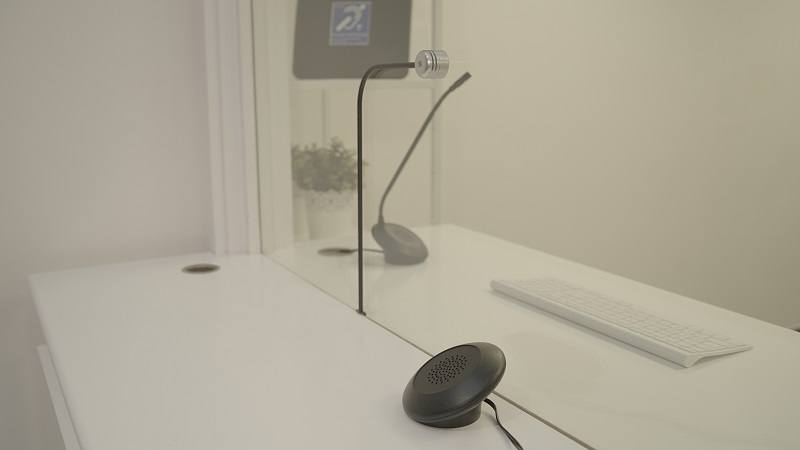Healthcare setting have changed considerably in the last 12 months, with Perspex or glass screens now comment at all points of patient interaction.
And, while these may help to reduce the spread of infection, they are a barrier to clear communication.
Not only does that risk misinformation to those in need of medical advice; but it also limits patient confidentiality because of the need to raise voices.
Add to this the increasing incidence of hearing loss as the population ages, and the need for technology to assist communication becomes even clearer.
Not all intercoms are created equal
Window intercom systems are a solution for enhancing communication speech where screens are in place.
And those with an ‘open duplex’ amplifier enable both parties to speak simultaneously, which is key for an efficient service and mutual understanding.
Andrew Thomas, market development director at assistive listening specialist, Contacta Systems, explains: “Being able to have a ‘normal’ conversation minimises stress for staff and patients, but particularly those with cognitive decline, speech and language difficulties, or people who have visual impairments and can’t use physical cues for conversation.
“Not hearing clearly can also be mistaken for a cognitive impairment, so it is essential that healthcare settings do their utmost to make communication as clear as possible.”
In noisy environments, such as hospital reception areas, high-quality speakers and microphones are essential to make sure speech is clear and to direct the sound to the patient or staff member and not across the seating area for everyone to hear.
Models are also available that will ‘sleep’ if they don’t detect conversation.
Being able to have a ‘normal’ conversation minimises stress for staff and patients, but particularly those with cognitive decline, speech and language difficulties
This means they can be left on to meet the needs of a 24-hour service, but energy costs are greatly reduced.
Thomas said: “Intercoms can be installed easily with very little disruption to either the fabric of the counter or the service to patients.
“Some systems can even be fitted to portable screens so clear and safe communication is available anywhere in the building.”
Meeting needs
It is estimated that one in five people in the UK has some form of hearing loss, and prevalence grows among the older age groups who are more likely to visit hospital.
And it is for this reason that healthcare settings should already having hearing loops in place which give those with hearing aids crystal-clear sound.
Thomas advises: “By switching to the T-coil position on their hearing devices, users receive sound direct from a microphone to their hearing aids, cutting out background noise.
“Patients can then hear their name called over the tannoy or a safety announcement, and premises meet BS8300 guidelines for making public spaces inclusive.
“Intercom systems can also be fitted with a hearing loop, so no matter what a patient or staff member’s hearing needs, speech can be clearly understood.”
Social distancing for staff
Recent research suggests that at a distance of 2m, the higher frequencies of speech can be reduced by as much as 12 decibels, depending on the type of mask the speaker is wearing.
Masks also remove most of the visual clues used in conversation, so training sessions can be challenging to hear, especially if the room has poor acoustics or attendees have any degree of hearing loss.
Sounds can be amplified in these environments either through light or radio waves, depending on the features of the space.
Thomas said: “Infra-red (IR) systems are ideal for larger spaces like lecture theatres.
“Transmitters fitted close to the ceiling flood the space with light, which is not subject to interference from power sources or metal within the structure of the building.
“Speech is then picked up via receivers with headsets and, because the light can’t pass through walls, the sound is contained within the space.”
For meeting rooms, where communication needs to be two way, radio frequency (RF) systems allow large groups to both listen and speak clearly.

Intercoms can be easily installed at a reception counter
And, with modern solutions, there is no need for installation as transmitters are simply plugged in, and rechargeable transceivers can be easily sanitised between users.
RF systems can also be used around the wards – and staff can comfortably stand apart and discuss patients at a discreet volume without the signa being affected by pillars or obstacles such as a nursing station or electrical equipment.
Expert assessment
When specifying a solution, Thomas advises: “Expert assessment of the space is vitally important for any assistive listening system.
“For example, hearing loop performance can be affected by the fabric of the building or sources of interference, such as air conditioning systems.
“Maintenance should also be planned to make sure the systems continue to work effectively.
“With Covid-safe measures likely to be needed for some time yet, this is a worthwhile investment to make for the current time and for the future.”




